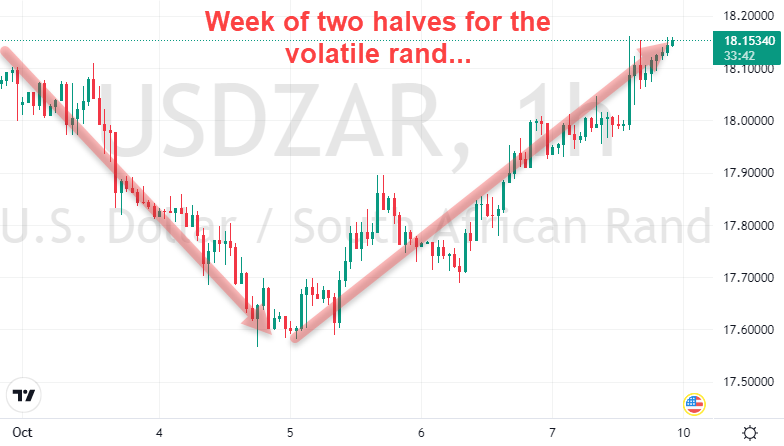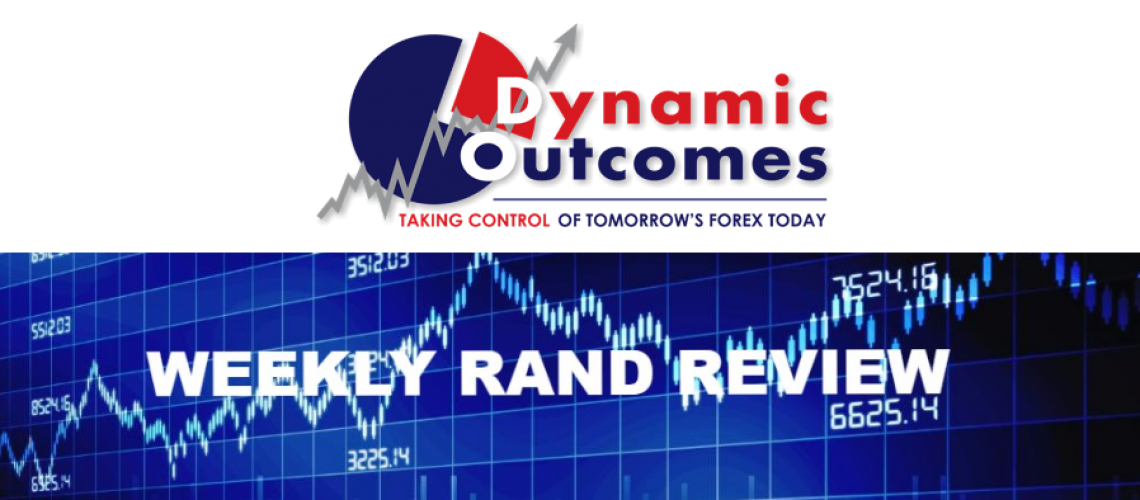Never a dull week in the trading world and last week was an absolute doozy! Q3 shocked the world, tossing up market turmoil, runaway interest rates, and firmly embedded the reality of a looming (and in some cases unavoidable) recession in several of the world’s leading economies.
While the US has adopted a firm and unwavering stance on a plan of action, we’ve seen other “developed” economies behave like emerging markets… most notably in the UK, where sensible policymaking seems to have gone down the tubes.
All the while, the local unit continues to flounder on the surface of a tempestuous sea that is the global market…
…in which the undercurrents became that much stronger in the past week. Strap in, it’s going to be a bumpy ride. Here’s how the week unfolded:
Key Moments (3-7 Oct 2022)
These were the major talking points for the week:
- SA PMI Knocked – Increased power cuts and soaring inflation led to steep falls in private sector activity. What is this going to do to the local GDP?
- Oil War Heats Up – On Wednesday, OPEC and its Russian-led allies agreed on a move that may prove to be a critical moment in the global fight against inflation as well as the conflict in Ukraine.
- UK Loadshedding – That’s right, the UK’s electricity system operator officially released a statement warning that 3-hour rolling blackouts may be implemented if gas supply falls short of demand.
- US Jobs Data – Markets eagerly awaited the crucial US jobs report due late in the week to provide further clues on a potential pivot in the US Fed’s rate-tightening trajectory.
We’ll kick off the week locally, where the Rand opened trade just over R18/$, relatively unchanged from its previous close.
The local unit firmed through the day, dropping to the mid R17.80/$ region as the greenback lost some support overnight and into Tuesday following economic data showing a slowdown in US manufacturing.
The Rand continued to gain ground and headed into midweek, changing hands at a touch below R17.60/$ ahead of the local PMI survey data, which was likely to provide a significant indication of the health of the economy.
The results, however, made for grim reading. SA’s private sector activity dropped in September to 49.2% from 51.7% in August as the effects of rolling power cuts and increased prices took effect!
Readings below 50% indicate a contraction in activity, and fears are certainly mounting around the state of the country’s GDP, with loadshedding firmly expected to continue for the foreseeable future.
Several countries saw inflation ease last month, mainly due to the drop in oil prices, but on Wednesday, everything changed:
OPEC+ dropped an absolute bombshell that threatens to undo all the hard work of global economies in trying to tame rampant inflation.
The 24 oil producing countries, which includes Russia, announced a 2 million barrels per day reduction in oil production in an attempt to drive oil and gas prices back up after weeks of a downward trend.
Oil prices had nosedived to sub-$90 per barrel regions in recent weeks from $140 levels during the early parts of the invasion of Ukraine…
…and this latest reduction by OPEC+ could turbocharge crude prices (using normal supply and demand, of course).
If we look at the recent history, then there are a few facts that become very interesting:
- The US-Saudi Arabian history has been a rocky one that has been tested on several occasions, many of which still remain unresolved.
- President Biden visited Saudi Arabia in July in an attempt to deal proactively with this exact situation. Seems now that it was a pointless trip?
- Russia’s ties with Saudi Arabia and other members of the Gulf Cooperation Council (GCC) have deepened since the lunch of the OPEC+ oil production agreement in 2016.
- Lower supply of oil + higher prices = more income for OPEC+, a major member of which is Russia.
- The Western nations have shunned Russian oil supply with sanctions and price caps while Asian nations such as China and India have stepped up as customers, buying those supplies at huge discounts to create a stockpile.
Which then leads to a burning question:
Is this oil cut by OPEC+ an actual market-driven decision or a political statement?
Bottom line – the US was not happy…
…what will follow will be most interesting to watch.
From a consumer perspective, needless to say, the decision will not go down well as motorists only just start to breathe some sigh of relief at the pumps!
Meanwhile, across the Atlantic in the UK, the news of further oil and gas reductions could not have come at a worse time with Brits already in the midst of an energy crisis.
Households are staring down the barrel of a cold and now seemingly dark winter.
Their electricity system operator warned that 3-hour power blackouts would be forced to be implemented if the gas supply runs short of demand…
Trouble is brewing in Britain, and has been for some time!
Inflation, fuel, and energy prices are at all-time highs and reports in the week suggest that there has been an 18% increase in people accessing their pensions for the first time. Are Brits being forced to cash in pensions prematurely to plug gaps in income? As for the Rand amidst this, we saw a rollercoaster of a week playing out:

And then in other news:
- The ECB released the minutes of its most recent meeting in September, where it decided to increase interest rates to 1.25% – the highest in European history. The main point noted was that the ECB acknowledged the extremely high inflation in the eurozone, and expects it to remain high for a long period of time, having broken double-digit levels already last month.
- US manufacturing activity dropped to 50.9% for September, down from 52.8% in August, recording its lowest level since May 2020. As inflation continues to stifle consumer spending, companies are going to be forced to manage headcounts due to uncertain demand.
- The SARB released the October 2022 Monetary Policy Review in the week, which made clear the expectations of the central bank to continue raising interest rates well into 2023 as it tries to guide inflation back toward the target level.
On Thursday, the local unit was trading at R17.73/$ at the first call but steadily receded toward the R18/$ mark ahead of the crucial US jobs data due on Friday…
…as local investors began leaning toward strong non-farm payrolls results in the US, which would likely spark a sell-off of risk assets.
And that’s exactly what happened.
The US economy added 263,000 jobs in September, which was slightly below expectation but still fairly strong, while the unemployment rate trickled down to 3.5% from 3.7% in August.
While these figures do suggest a strengthening jobs market, it does not take into consideration multiple jobbers that have taken up a second or third job as a means to maintain acceptable standards of living…
Nevertheless, what these figures are likely to do is pave the way for another bumper rate hike by the US Fed – as they continue to try to rein in inflation to the 2% target…
…which they have made clear is their top priority, even if it means sacrificing economic growth and jobs to achieve it. And that was the wrap!
The Week Ahead (10-14 Oct 2022)
It’s going to be a big week of economic data. Here are some of the key events:
- UK – Unemployment Rate; GDP YoY, BoE Credit Conditions Survey
- US – FOMC Minutes, PPI MoM, Inflation Rate YoY, Retail Sales MoM (SEP)
- SA – Gold and Mining Prodcution (AUG)
Following the US jobs report, emerging currencies were forced to give back any gains made in the week as investors piled back into the US dollar safe haven.
The local unit was not to be spared either, as it shot as high as R18.16/$ in the blink of an eye before leveling out to close the week at R18.09/$.
In the end, economic data proved to dictate market movement yet again as the jobs report sent the dollar back on its way to potential new record heights…
…and with fresh concerns over oil prices – a key driver of inflation – there’s no telling when it may be reined back in.
The only certainty right now is uncertainty! As for us? We’ll be relying on our Elliot-Wave based forecasts to provide some direction. You can too!

